
- •Contents
- •Preface
- •Abbreviations
- •1 Is This You or Someone You Love?
- •My Turn
- •This Book
- •All Hearing Losses Are Not the Same
- •The Importance of Hearing in Our Lives
- •The Trouble with Hearing Loss
- •Staying in the Game
- •Just a Bit About Sound
- •What Does the Brain Have to Do with Hearing?
- •The Peripheral Auditory System
- •The Central Auditory System
- •Summary
- •The First Step
- •Audiologists
- •The Goals of a Hearing Evaluation
- •Nonmedical Examination of Your Ears (Otoscopy)
- •Case History Information
- •Test Environment
- •Hearing Evaluation: Behavioral Tests
- •Hearing Evaluation: Physiologic Tests
- •Understanding Your Hearing Loss
- •Describing a Hearing Loss
- •5 What Can Go Wrong: Causes of Hearing Loss and Auditory Disorders in Adults
- •A Quick Review: Conductive, Sensorineural, and Mixed Hearing Loss
- •Origins of Tinnitus
- •Conventional Treatments
- •Alternative Treatments
- •7 Hearing Aids
- •Deciding which Hearing Aids Are Right for You
- •Hearing Aid Styles
- •Special Types of Hearing Aids
- •Hearing Aid Technology (Circuitry)
- •Hearing Aid Features: Digital Signal Processing
- •Hearing Aid Features: Compatibility with Assistive Listening Technologies
- •Hearing Aid Features: Listener Convenience and Comfort
- •Hearing Aid Batteries
- •Buying Hearing Aids
- •The Secret of Success
- •How a Cochlear Implant Works
- •Cochlear Implant Candidacy
- •Expected Outcomes for Cochlear Implant Users
- •Cochlear Implant Surgery
- •Device Activation and Programming
- •Choosing Among Cochlear Implant Devices
- •Auditory Brainstem Implants
- •Current and Future Trends
- •9 Hearing Assistance Technology
- •Hearing Assistance Technology
- •Telephones and Telephone Accessories
- •Auxiliary Aids and Services
- •Alerting Devices
- •Hearing Service Dogs
- •Hearing Rehabilitation
- •Hearing Rehabilitation Services
- •Hearing Rehabilitation Services Directly Related to Hearing Aids
- •Hearing Rehabilitation Services beyond Hearing Aids
- •Support/Advocacy Groups
- •The Americans with Disabilities Act of 1990
- •Summary: Good Communication Habits
- •11 Prevention of Hearing Loss
- •Preventable Causes of Hearing Loss
- •Hearing Loss Caused by Noise Exposure
- •Hearing Loss Resulting from Ototoxicity
- •APPENDICES
- •Notes
- •Resources
- •Index

CHAPTER 9
Hearing Assistance Technology
Sweet is every sound, sweeter the voice, but every sound is sweet.
Alfred Lord Tennyson
If your hearing loss can’t be corrected medically, obtaining two hearing aids and learning to make the very best use of them should be among the first steps you take. Only a tiny percentage of people with hearing loss can’t be helped by hearing aids. Hearing aids can improve your ability to function in nearly all situations; nevertheless, some situations will be difficult even with hearing aids, especially if your hearing loss is severe. Hearing assistance technology (HAT) supplements the benefits provided by hearing aids. HAT is designed to improve your ability to function independently and to communicate in difficult listening situations, whether you use hearing aids or not. It can benefit people with any degree of hearing loss. Although some technologies are especially helpful to persons with severe and profound hearing loss, others can substitute for hearing aids if the listener’s hearing loss is mild. Every person with hearing loss should consider hearing assistance technology.
If you don’t wear hearing aids, you can benefit from almost any type of assistive listening technology by wearing headphones or earbuds. If you do wear hearing aids, there are a variety of ways to achieve a direct (wired or wireless) connection between your hearing aids and nearly any sound source: a movie, telephone, concert, television, computer, worship service, stereo, lecture, personal music player, or friend wearing a microphone. With hearing aids, it’s all about connectivity. The hearing aids that allow the greatest connectivity are behind-the-ear (BTE) hearing aids.

Hearing Assistance Technology |
169 |
HEARING ASSISTANCE TECHNOLOGY
Hearing assistance technology (HAT) is an umbrella term that’s used to cover a broad range of services and technologies designed to help people with hearing loss. HAT can be divided into four general categories: assistive listening devices and assistive listening systems (ALD/S), telephones and telephone accessories, auxiliary aids and services, and alerting devices.
Assistive listening devices (ALDs) and assistive listening systems (ALSs) make up a large and diverse category. ALDs are personal units that allow people to receive sound directly from almost any source, in most cases with a wireless connection. ALSs work in conjunction with the sound systems used in public facilities. While the sound system is broadcasting to normally-hearing patrons through loudspeakers, the ALS is transmitting the same signal directly to receivers worn by patrons who are hard of hearing.
Another large and diverse category includes telephones and telephone accessories. Using the telephone can be very challenging for people with hearing loss (visual cues are unavailable, important frequencies are filtered out, and volume is often inadequate). Dozens of specialty telephones and telephone accessories are available to improve telephone communication with or without hearing aids.
The auxiliary aids and services category represents a blend between services and technology, and includes captioning, computer-assisted real-time transcription (CART), computer-assisted note-taking, interpreter services, and the use of written materials.
The final category includes devices that substitute light or vibration for sounds in the environment; for example, a flashing light or vibration might let a listener know when a smoke alarm goes off, a doorbell rings, or an alarm clock buzzes. For the most part, these technologies are intended for people who have considerable hearing loss.
Unfortunately, assistive services and technologies usually aren’t covered by Medicare or private health insurance plans (although one should always check). Depending on the circumstances, they may be provided in conjunction with the Americans with Disabilities Act (ADA; see Chapter 10). State vocational rehabilitation agencies, the Department of Veterans Affairs, and Medicaid can be other sources of funding. Assistive devices are most often purchased through mail order catalogs, over the Internet, and in specialty retail stores (for example, Radio Shack and Best Buy). Some audiologists offer them in their offices, but not often enough, and the selection is usually limited. Because the array of devices is vast, diverse, and ever changing, it’s difficult for audiologists to stock, display, and dispense them in their practices.
Hearing assistance technology can be incredibly helpful; however, most consumers are unaware that such technologies exist, or they don’t know

170 |
The Praeger Guide to Hearing and Hearing Loss |
where to find them. And regrettably, audiologists often fail to provide adequate information about HAT. The Rehabilitation Engineering Research Center (RERC) at Gallaudet University (Washington, DC) is developing a software program that can assist audiologists in analyzing a person’s needs and identifying particular assistive technologies to meet those needs. The program highlights specific devices and vendors and suggests other hearing rehabilitation procedures that could be of benefit.1 In the meantime, you’ll probably need to do some research on your own. This overview is intended to give you an idea of the types of products and services that are available and to encourage you to try some of them. Use the information provided in the Resources section to search for the best possible solutions to the problems that you experience and to stay current; assistive technologies change constantly as new features and new devices are introduced. The annual convention of the Hearing Loss Association of America (formerly SHHH) is probably the best place to see new technologies and learn about them from company representatives. Always consult with your audiologist before making a purchase, however, so that she can advise you about a device’s compatibility with your hearing aids.
Connectivity is an important issue that should be considered when you’re fit with hearing aids. Hearing aids with features like telecoils, FM receivers, and direct audio input (DAI) capability (more on this later in the chapter; also see Chapter 7) offer the most flexibility in terms of interfacing with assistive technology. These features are most often found in BTE (and, to a lesser degree, ITE) hearing aids. BTEs offer more options than any other hearing aid style.
ASSISTIVE LISTENING DEVICES AND ASSISTIVE
LISTENING SYSTEMS
Situations in which people with hearing loss have the greatest difficulty understanding speech typically are characterized by one or more of these problems:
Distance separating the listener and speaker (or the listener and another sound source of interest). Loudness decreases quickly over distance, and the weakest sounds (which are most important to speech understanding) are lost first. Furthermore, the range of a hearing aid microphone extends only 6 to 12 feet.
Background noise that competes with the speaker’s voice. Although contemporary hearing aids have features designed to make understanding speech in background noise easier, this remains a challenge (see Chapter 7). Even the most advanced hearing aid can’t compete with the human ear when it comes to understanding one conversation in the midst of many. For optimal understanding, speech (the signal) must be considerably louder than the competing noise (this is known as a favorable signal-to-noise relationship [SNR]).

Hearing Assistance Technology |
171 |
Reverberation or poor room acoustics. A reverberant room is one with lots of hard surfaces (hard walls, hard floor, hard ceiling, hard furniture) and few sound-absorbing materials (drapes, carpeting, ceiling tile, upholstered furniture). Sounds bounce off the hard surfaces, creating echoes that reach the ear at different times. Overlapping signals blur the original signal, “smearing” it and making it difficult to understand. Classrooms, cafeterias, and gymnasiums tend to be highly reverberant.
Distance, noise, and reverberation are classic “degraders” of speech understanding. They cause difficulty for all listeners, even those with normal hearing. For listeners with hearing loss who are already missing cues important to speech intelligibility, however, it takes less distance, less noise, and less reverberation to degrade speech understanding.
What’s the solution? It’s not turning up the volume on your hearing aids; that increases the signal, but it also increases the noise. Moving closer to the speaker would be a better solution. Putting your ear 8 to 12 inches from the speaker’s mouth would be ideal, but it’s not very practical. Fortunately, the same thing can be accomplished using remote microphone technology. Remote microphone technology increases the loudness of the signal (the signal is the sound you want to hear) without increasing the background noise. In other words, remote microphone technology makes the relationship between the signal and the noise more favorable. Technically, the signal-to-noise relationship is called the signal-to-noise ratio, or SNR. Improving the SNR is the most effective way to improve speech understanding in poor listening conditions.
What is remote microphone technology? Instead of relying on the hearing aid’s microphone to pick up the speaker’s voice, the speaker uses a remote microphone (remote from your hearing aid), and her voice is sent directly to you (more about how it’s sent coming up). The ALD/S creates a wireless connection between you and the speaker, bypassing the noise and reverberation in the room. You can increase the loudness of the speaker’s voice as much as you like without increasing the loudness of the noise. It makes no difference where you are in the room; your ability to hear the speaker is the same. In fact, all listeners wearing receivers can hear the speaker above the noise.
Let’s imagine how this works. Let’s say that you’re attending a meeting in a large room with 20 people seated around or near a conference table. The presenter is standing at one end of the room; you arrived late, so you’re seated at the opposite end. She uses her computer to make a portion of the presentation. For this segment, the lights are dimmed and her back is to you. The other people in the room are listening, but they’re also making noise (clearing their throats, moving their chairs and feet, shuffling papers, pouring water/coffee, consuming doughnuts). Because the room is reverberant, noises bounce off hard surfaces and “smear” the presenter’s words. The room noise (original and reverberated) is closer to you—and therefore

172 |
The Praeger Guide to Hearing and Hearing Loss |
louder—than the soft-spoken presenter. In a situation like this, the SNR is poor and you struggle to hear. How much you struggle depends on your hearing loss, the vocal qualities and speech characteristics of the presenter, the size of the room, and room acoustics. The presenter’s words, already weakened by distance, can be overwhelmed. To make matters worse, you can’t depend on visual cues. Now imagine that you’re using a personal ALD. You’ve asked the presenter to clip a tiny microphone to her lapel (there are other microphone options as well). You wear a small receiver of some sort, perhaps it’s inside your hearing aids. There are no wires, cords, or cables connecting the two of you. Now the presenter’s words go directly to your hearing aids. The distance between you has effectively been eliminated, and her voice doesn’t mix with the noise and reverberation in the room. Even when she turns away, the signal stays strong and clear because the microphone is still close to her mouth. The SNR is improved by as much as 20 dB; in other words, her voice is perhaps ten times louder than the noise in the room.
Let’s make one more adjustment to this scenario. With the hearing aid microphone turned off, the presenter’s voice coming from the remote microphone is the only input to your hearing aid. This gives you the very best SNR. Now, however, you have difficulty hearing your colleagues when they ask questions and make comments. Ideally, your hearing aid microphones can be activated along with the remote microphone. In this case, the remote microphone provides the primary input, and the hearing aid microphones provide secondary input. Although using both microphones at the same time decreases the SNR a bit, the signal from the remote microphone is adjusted to be louder than signals picked up by the hearing aid microphones. Either way, the presenter’s voice is louder and clearer than it would have been using hearing aids alone.
Assistive Listening Systems
The Americans with Disabilities Act (ADA) requires public and private facilities that provide sound systems for their patrons to offer an assistive listening system for patrons who are hard of hearing or deaf. This includes theaters, movie houses, concert halls, auditoriums, arenas, stadiums, meeting rooms, lecture halls, performance spaces, courtrooms, and more. Facilities of this type normally amplify sound and broadcast it through loudspeakers to the audience. By adding special equipment to the regular sound system, the same signal can be transmitted directly to people wearing special receivers. Assistive listening systems can make a remarkable difference in the ability to enjoy recreational, social, cultural, educational, political, and civic activities. Although exempt from the law, many places of worship offer assistive listening systems as well.
Imagine that you go to a theater to enjoy a play or movie, or maybe you’re attending a service at your place of worship. Unless you’re sitting

Hearing Assistance Technology |
173 |
very close to the loudspeaker, it may be difficult for you to understand the words that are spoken. Connecting to the facility’s assistive listening system can enable you to hear the words as if they were spoken 8 to 12 inches from your ears. The effects of distance and background noise are effectively eliminated.
The law requires that clearly visible signs be posted at a facility’s entrance indicating the availability of an assistive listening system and the location where receivers can be obtained (see Appendix C). Patrons borrow the equipment and return it before leaving the facility. There’s no charge, but a driver’s license (or another form of identification) may be required as a deposit. At least one employee should be available to instruct patrons about how to use the system.
Unfortunately, some expensive assistive listening systems merely collect dust. There are several possible reasons for this. Often, people are simply uninformed about their right to have this type of accommodation. In addition, facilities sometimes do a poor job of advertising a system’s availability, or staff members are unable to instruct patrons about its use. Patrons may be confused about how the system works with their hearing aids or have concerns about hygiene. However, the most likely reason is that people fear they will be conspicuous. Unfortunately, when a system gets little use, a facility’s staff may be uninformed, and equipment may be poorly maintained (for example, batteries may not get recharged). People need to look (or ask) for accommodations in public places and use them. A little advance scouting can be helpful. When planning to attend an event, drop by the facility ahead of time so that you can learn about the system and how it can meet your needs (if that’s not possible, call the facility or visit their website).
Why suffer through an event when it’s possible to hear better? Why not enjoy the event that you’ve paid to see? If a facility already has an ALS, teach yourself to use it (don’t worry; it’s quite simple). Once you’ve done that, you can educate other patrons and even employees. If you encounter a facility that doesn’t have a system, politely ask that one be installed. Be assertive; the ADA says that disabled people have the right to access the same goods, services, and facilities that are available to nondisabled people. If you use a wheelchair, you have the right to a ramp. If you have a hearing loss, you have the right to an assistive listening system.
Assistive Listening Devices
An ALD is a sound system on a smaller scale. Usually, a microphone is worn by a speaker or placed close to a sound source of interest. The listener wears a special receiver (which can be part of a hearing aid). ALDs can improve communication in virtually any situation. They can also relieve the stress and fatigue that difficult situations create.

174 |
The Praeger Guide to Hearing and Hearing Loss |
An ALD can also create a direct connection between an external sound source—like a television—and a listener. People with hearing loss often drive everyone else in the house (or on the block!) crazy when it comes to television volume. In fact, television volume often tops the list of complaints from family members. An ALD transmits sound directly from the TV to a receiver worn by the listener (again, the receiver can be part of the listener’s hearing aid). This makes sound from the television louder and clearer because it’s not degraded by distance and noise in the room. The user can increase the volume on the hearing aids or the ALD without increasing the volume on the TV itself; the TV can even be muted. The connection between the listener and the television can be wireless or hard wired.
Wireless Signal Transmission
How does the signal travel from the remote microphone to the receiver worn by the listener? There are three different means of wireless transmission: induction loop (IL), frequency modulation (FM), and infrared (IR). All three can provide a high-quality signal and improve the SNR by roughly the same amount. All three can be used with personal ALDs as well as the systems used in public places, and all three can be used with or without hearing aids. Each has advantages and disadvantages that can make it the best choice in a particular situation.
To some extent, all three types of wireless transmission work in a similar fashion. For example, a remote microphone can be worn by a speaker. The job of any microphone is to pick up sound and change it into an electrical signal that can be amplified. The amplified signal is then transmitted (by a transmitter) to a receiver worn by a listener. The job of a receiver is to receive the electrical signal and change it back into sound. The sound then gets delivered to the listener’s ears through a headset or the listener’s hearing aids. The difference between the three wireless technologies is how sound is carried from the source to the receiver.
Induction Loop Transmission and Telecoils
With induction loop (IL) technology, sound is picked up by a microphone worn by a speaker, changed into an electrical signal, and sent to the system’s amplifier, which makes it stronger. The electrical signal from the amplifier is sent to a wire that loops around a listening area. The electrical signal in the wire creates an electromagnetic field inside the loop that can be picked up by a telecoil inside a hearing aid (H/A). The telecoil, originally designed to improve telephone communication (see Chapter 7), serves as the ALD/S receiver, making a separate receiver and headset unnecessary. When a telecoil is used with an ALD/S, the hearing aid may allow the remote microphone and hearing aid microphone to be active at the same
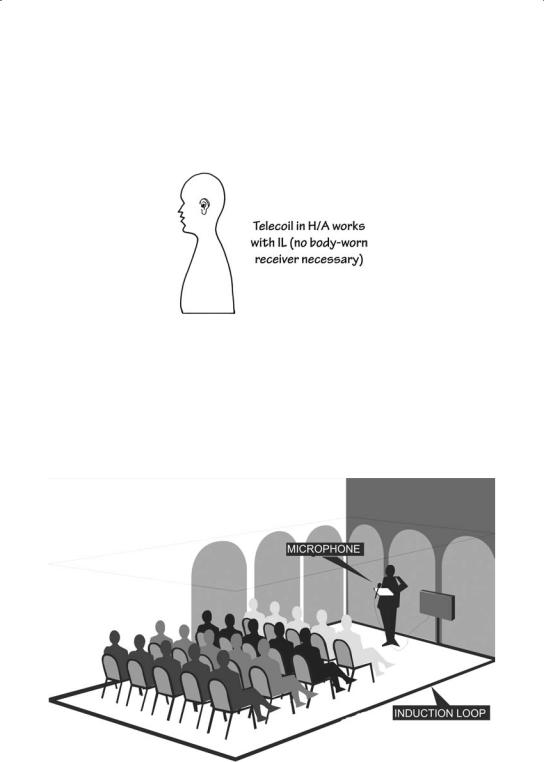
Hearing Assistance Technology |
175 |
time, making it possible to hear the speaker more clearly while still hearing people nearby. In contrast, when a telecoil is used with a telephone, the hearing aid’s microphone is turned off (eliminating room noise), and the telephone provides the only input to the hearing aid.
Listeners who wear hearing aids without telecoils can remove them and wear an IL receiver with headphones or earbuds. However, this means that the signal isn’t customized by the settings programmed into the hearing aids. It’s sometimes possible to wear headphones over hearing aids, especially if they’re completely-in-the-canal (CIC) aids. It may be necessary to turn down the hearing aid volume (to avoid feedback) and turn up the
Figure 9.1. Example of an Induction Loop Assistive Listening System. The speaker’s voice is picked up by the microphone, amplified, and sent to a wire that loops the room. Within the loop, an electromagnetic signal is picked up by the telecoil inside a listener’s hearing aid or by a body-worn IL receiver worn with a headset. (Courtesy of Ampetronic Ltd.)

176 |
The Praeger Guide to Hearing and Hearing Loss |
ALD/S volume to compensate, however. Headphones made of soft materials are less likely to cause feedback. Listeners without hearing aids can also use an induction loop by wearing a receiver with headphones or earbuds.
The primary disadvantage of induction loop technology is that most hard of hearing people don’t wear hearing aids, and among those who do, many don’t have telecoils. Despite their versatility and relatively low cost, telecoils are included in only about 60 percent of the hearing aids sold in this country, probably because they don’t fit inside smaller hearing aids like CICs. In the United Kingdom, both telecoils and induction loop systems are far more popular. Listeners in the United States have become more aware of telecoils due to the efforts of David Myers, a psychology professor at Hope College in Holland, Michigan. Traveling in Great Britain, Myers, who’s severely hard of hearing, discovered the convenience and outstanding sound quality offered by loop systems. He described his experience in an 800-year-old abbey with high stone walls:
. . . noticing a hearing assistance sign . . . my wife suggested I activate the telecoils that came with my new hearing aids. When I did, the transformation was dramatic. Suddenly the babble of people awaiting the start of the service was replaced by the pure harmonies of the musicians—whom I had not even heard—playing in front of microphones across the abbey. It was like listening to a CD over a headset. When the liturgy began, the leader’s words seemed to travel directly from her microphone to the center of my head. Her voice could not have been more distinct.2
Myers returned to start the “Let’s Loop America” campaign (see the Resources section for contact information). Subscribing to the philosophy of “if you build it, they will come,” Myers believes that if communities begin looping listening areas in public places, more people will opt for hearing aids that contain telecoils. Indeed, in Myers’s small community, dozens of churches and public facilities have been “looped” within the past several years, and more people are opting for hearing aids with telecoils. Myers believes the public will gradually come to see loop systems as the most convenient and cost-effective assistive listening format. He notes, for example, that areas where it would be impractical to check out and return equipment (such as ticket windows, airport gates, and information desks)

Hearing Assistance Technology |
177 |
could be looped. People would simply switch their hearing aids to the telecoil setting and communicate with someone wearing a small microphone.3,4
William and Christine Diles, California audiologists, make residential loop installation a complementary option for anyone who purchases hearing aids with telecoils. They’ve “looped” more than 1,000 homes, 40 banks, several churches, a pharmacy, and a movie theater. They report that their patients are enthusiastic about using loops and telecoils at home and in facilities around their communities.
Advantages of Induction Loops and Telecoils
Listeners who have telecoils in their hearing aids don’t need to wear special receivers and headsets to use an induction loop system; they simply switch their hearing aids to the telecoil setting (this can be done by touching a button on the hearing aid or a remote control).
Listeners with telecoils don’t need to borrow receivers and headsets to use the ALS at a public facility. They can attend an event confident that their receivers are working properly, rather than relying on receivers maintained by the facility.
All telecoils work with all induction loops, eliminating compatibility issues between personal receivers (telecoils) and the IL systems used in public places.
Used with a neckloop or silhouettes (see later discussion), telecoils make hearing aids compatible with other wireless transmission systems (FM and infrared), personal communicators, and external sound sources.
Listeners with telecoils hear a signal that is customized by the settings programmed into the hearing aids.
Listeners with two telecoils receive a binaural signal.
The transmitter of a personal IL unit can be plugged into an external sound source (like a television); within a looped space, sound from the television is picked up by the telecoils inside a listener’s hearing aids (the connection between the television and the listener is wireless).
Many hearing aids allow the telecoil and hearing aid microphones to be active at the same time (allowing listeners to communicate with the people around them); in this case, the telecoil provides the primary input to the hearing aid, and the hearing aid microphones provide secondary input.
Telecoils and induction loops are less expensive than FM or IR technology.
Disadvantages of Induction Loops and Telecoils
Most people who are hard of hearing don’t wear hearing aids, and among those who do, many don’t have telecoils.
Telecoils fit in all behind-the-ear (BTE) hearing aids and some mini-BTE, in- the-ear (ITE), and in-the-canal (ITC) hearing aids. However, they typically don’t fit in CIC aids.

178 |
The Praeger Guide to Hearing and Hearing Loss |
The signal from an induction loop is not always consistent; occasionally, reception can be affected by head orientation or a listener’s position in the room (there can be “dead spots” in the electromagnetic field).
Telecoils are subject to electromagnetic interference (buzz) produced by computer monitors, computer power supplies, fluorescent lights, dimmer switches, microwaves, power lines, copiers, fax machines, and some appliances.
The signal from an induction loop can spill over into another room (a potential problem when privacy is a concern, as in a courtroom).
Personal IL devices don’t offer the portability and versatility of personal FM units.
Induction Options
There are three induction options:
Area Loops
Almost any area can be looped (classrooms, reception windows in offices, lecture halls, car interiors, kitchen tables, information desks, teller windows, family rooms, or favorite chairs).
The induction loop wire can be permanently installed under a carpet, along the baseboards, on the ceiling, in the basement, or in the attic. Installation is relatively simple; many people do it themselves (when that’s not possible, check with a carpet installer or an electrician). After installation, the loop should be relatively maintenance free.
Temporary loops can be set up for meetings or special events.
Everyone inside the loop who has telecoils in their hearing aids can pick up the signal.
Neckloops
A neckloop is worn like a long, loose-fitting necklace by someone who has telecoils inside his hearing aids. The neckloop creates an electromagnetic field around a listener’s head similar to the electromagnetic field created by an induction loop that encircles a room. The telecoils inside the hearing aids pick up the signal from the electromagnetic field. The neckloop can be plugged into an FM or infrared (IR) receiver, making any hearing aid with a telecoil compatible with FM and IR wireless transmission.
A neckloop can be worn under clothing; there are no cords or wires connecting it to the hearing aids.
A neckloop can be plugged into almost any external sound source (such as a television).
Silhouettes
A silhouette looks like a very thin, flat BTE case with a cable coming out of the bottom; it hooks over the ear like a BTE.

Hearing Assistance Technology |
179 |
Figure 9.2. Example of a Neckloop Plugged into an IR Receiver. (Courtesy of Sound Associates, Inc.)
The cable plugs into the receiver of an FM or IR assistive listening device or system, making any hearing aid with a telecoil compatible with FM and IR wireless transmission.
A silhouette can also be plugged into almost any external sound source (like a television).
A silhouette is less sensitive to head orientation than are area loops or neckloops.
A silhouette is worn closer to the telecoil than an area loop or neckloop, which means that a more powerful electromagnetic signal is available for listeners with more severe hearing loss. If the additional power is not needed, the electromagnetic signal can be kept relatively low, making it less susceptible to interference.
FM Transmission
An assistive listening device or system that uses FM transmission is basically a small radio station. With a personal ALD, the signal from a remote microphone (worn by a speaker, for example) is broadcast via FM radio waves to a listener wearing a receiver that’s tuned to the same frequency. Similarly, an ALS in a public facility takes the signal from the sound system and broadcasts it via FM radio waves to audience members wearing receivers tuned to the appropriate frequency.
With a personal FM device, the microphone/transmitter can be worn by the speaker, held and aimed at the speaker by the listener, placed on

180 |
The Praeger Guide to Hearing and Hearing Loss |
Figure 9.3. Example of an FM Microphone/Transmitter Plugging into the Headphone Jack of a Television. The transmitter will broadcast the signal directly to an FM receiver worn by the listener. The connection to the listener is wireless. (Courtesy of Phonak.)
a podium, or set in the middle of a conference table. Personal FM devices can be used virtually anywhere; they’re more portable and more versatile than personal IL or IR units. For example, a couple (or anyone else) could use an FM device in a noisy restaurant, in the car, or while taking a walk or a bicycle ride. Alternatively, an FM transmitter can be plugged into an external sound source (like a television). The connection between the sound source and the listener is wireless.
The FM signal can be delivered to the listener’s ears in one of several ways:
Some BTE hearing aids have FM receivers built inside; therefore there’s no need to wear a separate receiver. Some automatically switch to FM mode when they sense an FM signal and switch back to microphone mode when the signal is no
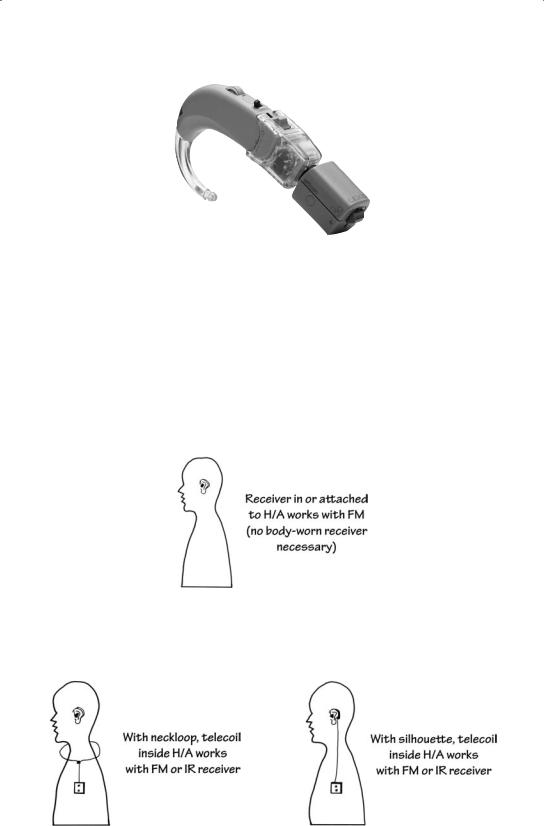
Hearing Assistance Technology |
181 |
Figure 9.4. Top (left) to bottom (right), BTE Hearing Aid, Boot (Audio Shoe) Adapter, and FM Receiver. (Courtesy of Oticon, Inc.)
longer present. In other cases, the listener switches to FM mode manually by touching a button on the hearing aid or remote control.
A tiny receiver can be connected to a boot or audio shoe adapter and snapped onto the bottom of almost any BTE hearing aid; again, this eliminates the need for a separate receiver (Figure 9.4).
If the hearing aid has a telecoil, a neckloop (see Figure 9.2) or silhouette can be plugged into the earphone jack of an FM receiver.
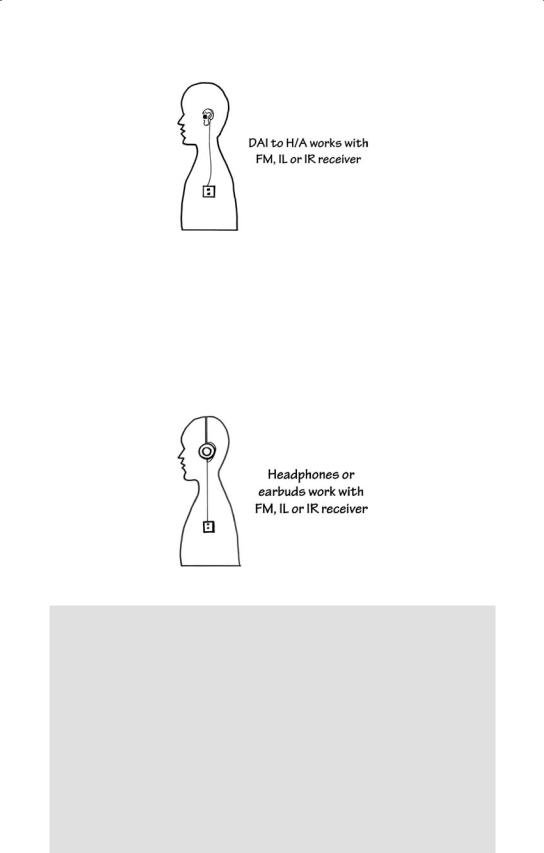
182 |
The Praeger Guide to Hearing and Hearing Loss |
A hearing aid with direct audio input (DAI) capability or a DAI boot (see later discussion) can be connected to an FM receiver with a patch cord.
If the hearing aids don’t have integrated FM receivers, telecoils, or DAI (and the hearing loss is not too severe), a listener may be able to remove the aids and use headphones or earbuds connected to an FM receiver. In this case, the signal would not be customized by settings programmed into the hearing aids. Occasionally, listeners can wear headphones over their hearing aids, especially if the aids are CICs. A listener without hearing aids can also wear headphones or earbuds connected to an FM receiver.
Advantages of FM Transmission
Receivers can be incorporated into BTE hearing aids or connected to BTE hearing aids with adapters (see Figures 7.8 and 9.4), eliminating the need for a body-worn receiver and headset. A body-worn receiver is similar to a pager and can be worn under clothing, in a pocket, or clipped to a belt.
If the signal goes through the hearing aids, it is customized by the settings programmed into them by the audiologist.
Listeners with two ear-level receivers receive a binaural signal.
Personal FM units are highly portable and highly versatile; they offer the greatest flexibility of movement.
A listener can pick up the FM signal throughout the house (no more shouting from room to room).
FM is the only wireless transmission mode that can easily be used outdoors.

Hearing Assistance Technology |
183 |
The transmitter for a personal FM unit can be plugged into an external sound source (like a television). Sound from the television is broadcast directly to a personal FM receiver; the connection to the listener is wireless (see Figure 9.3).
Many hearing aids allow the FM and hearing aid microphones to be active at the same time (allowing the user to communicate with the people around him).
No installation is required.
FM transmission offers more power to accommodate severe and profound hearing losses.
Disadvantages of FM Transmission
FM transmission is subject to interference from other communication devices operating in close proximity, such as nearby radio stations, pagers, police band radios, emergency vehicles, walkie-talkies, other FM devices/ systems, etc.
The FM signal can spill over into other rooms (a problem when privacy is a concern).
Ear-level FM receivers (in or attached to hearing aids) generally require BTE hearings aids. Some people prefer custom hearing aids.
FM units are relatively expensive.
Wireless Communication for Small Groups
A new system addresses the need to hear multiple talkers in a group setting. Although the transmission technology differs, this system functions like a variation on a personal FM device—with a significant advantage. A conventional FM device has a single microphone/transmitter that broadcasts to one or more receivers (as would be used in a classroom setting, for example); in contrast, this system has a single receiver and up to four microphones/transmitters. This means that one to four companions can wear remote microphones that transmit to a listener wearing a receiver, making it possible for the listener to interact comfortably with more than one person at a time (see figure 9.5). This means, for example, that the user could dine with up to four other people in a noisy restaurant or play cards as part of a foursome. The unit can also be used like a traditional FM device for one-to-one communication.
Infrared Transmission
With infrared transmission, invisible beams of light are used to carry sound from its source to one or more listeners wearing receivers. Infrared receivers have not been built into hearing aids, nor are they available

184 |
The Praeger Guide to Hearing and Hearing Loss |
Figure 9.5. Up to Four Talkers Wearing Microphone/Transmitters that Broadcast to a Receiver Worn by the Listener. (Courtesy of Etymotic Research, Inc.)
in adapters that connect to hearing aids. Instead, infrared is used with telecoils in hearing aids, hearing aids that have direct audio input (DAI; discussed later), or, more commonly, headsets that replace hearing aids:
Listeners with telecoils in their hearing aids can plug a neckloop or silhouettes into the IR receiver.
Listeners with hearing aids that have DAI capability can plug the IR receiver into their hearing aids using patch cords.
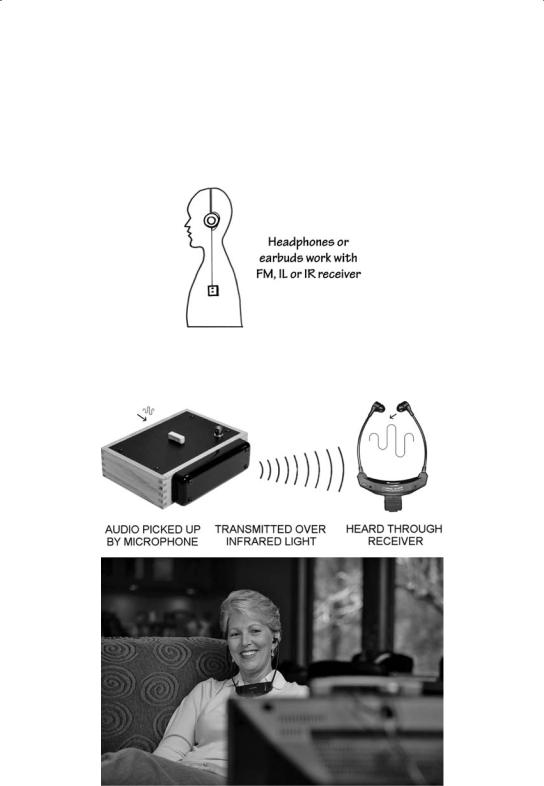
Hearing Assistance Technology |
185 |
If the hearing loss is not too severe, the listener can remove the aids and use headphones or earbuds connected to the IR receiver, although in this case the signal isn’t customized by the settings programmed into the hearing aids. Occasionally, listeners can wear headphones over their hearing aids, especially if they’re CICs. Listeners without hearing aids can wear a receiver with headphones or earbuds.
A popular IR receiver style looks something like a stethoscope attached to earbuds. The lightweight receiver hangs below the chin. There are also
Figure 9.6. Top, Infrared Transmission to a Stethoscope-type Receiver. Bottom, Stethoscope-type Receiver Worn by a Listener Watching Television. (Courtesy of Sound Choice Assistive Listening, Inc. [top] and Clarity, a division of Plantronics, Inc. [bottom].)
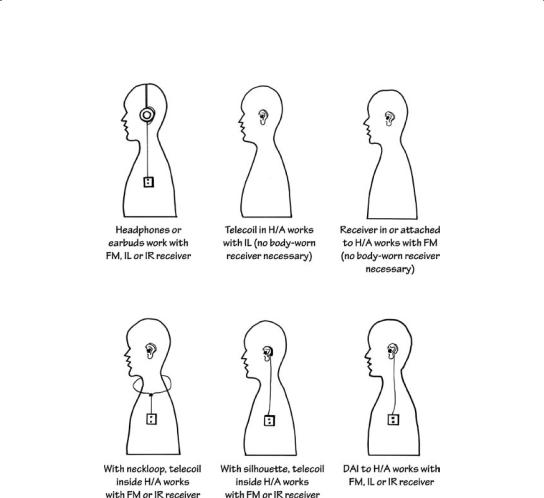
186 |
The Praeger Guide to Hearing and Hearing Loss |
(1) |
(2) |
(3) |
(4) |
(5) |
(6) |
Figure 9.7. Receiver Options for Wireless Technology. Left to Right: (1) Listeners without hearing aids can wear headphones/earbuds plugged into an FM, IL, or IR receiver. Listeners with hearing aids can remove them and wear headphones/earbuds with a receiver. In some cases, listeners can wear headphones over their hearing aids. (2) Listeners with telecoils in their hearing aids simply switch to the telecoil setting to receive an IL signal. (3) Listeners with FM receivers in their hearing aids (or attached to them with boot adapters) don’t need a separate receiver to receive an FM signal. (4) Listeners with telecoils in their hearing aids can wear a neckloop plugged into an FM or IR receiver. (5) Listeners with telecoils can wear silhouettes plugged into an FM or IR receiver. (6) Listeners with DAI capability can plug their hearing aids into an FM, IL, or IR receiver with a patch cord. (Adapted from work created by Cynthia Compton-Conley.)
wireless earphones with built-in infrared receivers. Some receivers contain a microphone that enables the listener to hear others in the room while using the IR unit. Personal IR devices are especially popular for television viewing.

Hearing Assistance Technology |
187 |
Advantages of Infrared Transmission
Unlike IL and FM transmission, the infrared signal doesn’t spill over into other rooms, which is important when privacy is a concern (for example, during courtroom proceedings, business meetings, performances using copyrighted material).
An unlimited number of individual transmitters can operate simultaneously in the same building, as long as they’re in separate rooms.
An IR transmitter can be plugged into an external sound source (like a television). Sound from the television is broadcast directly to the IR receiver. The connection between the television and listener is wireless.
Disadvantages of Infrared Transmission
Unlike IL and FM, IR receivers have not been built into hearing aids or adapters that connect to hearing aids; this usually makes wearing a receiver and headset necessary.
Sometimes IR units can’t be used outdoors or in rooms with exceptional natural light because of light interference.
The receiver must be able to “see” the IR light; this means it can’t be worn under clothing.
Personal IR units don’t offer the portability and versatility of personal FM units.
Hard-wired Assistive Listening Devices
Direct Audio Input
Direct audio input (DAI) capability is an optional feature on some BTE hearing aids (see Chapter 7). Some hearing aids have DAI jacks; in other cases, a universal DAI boot adapter slips over the end of almost any BTE hearing aid. Using a special patch cord, it’s possible to plug a hearing aid directly into an external sound source (the sound source could be a television, telephone, stereo, radio, computer, personal music player, or something else). A hearing aid with DAI capability can also be plugged into the receiver of an assistive listening device or system. DAI enables sound to be customized by the settings programmed into the listener’s hearing aids.

188 |
The Praeger Guide to Hearing and Hearing Loss |
Figure 9.8. Examples of Personal Communication Devices. The device connects to the listener with a cable. (Courtesy of Clarity, a Division of Plantronics, Inc. [left] and Phonic Ear [right].)
Personal Communication Devices
Personal communication devices, sometimes called one-to-one communicators or personal amplifiers, are hard-wired devices in which a cable connects the microphone and the listener. The unit is generally about the size of a pager or television remote and contains a microphone, amplifier, and battery; it attaches to headphones or earbuds with a cable. The microphone can be built into the unit or it can be detachable. In some cases, an additional microphone can be ordered. The microphone can be worn by the speaker, held by the speaker, placed close to the speaker, or held by the listener and aimed at the speaker. In any case, the microphone and the listener are connected by cables. Alternatively, the unit can be plugged into a sound source (like a television, telephone, or ALD receiver). Although personal communicators generally aren’t worn with hearing aids, hearing aid users with telecoils can plug a neckloop or silhouette into the unit and hear through their hearing aids.
Hard-wired devices are portable, easy to use (no installation is necessary), and considerably less expensive than wireless systems (less than $200). A personal communicator can be a reasonable substitute for hearing aids in certain situations (for example, during a hospital stay when wearing hearing aids isn’t possible, when hearing aids are away for repair, or for a homebound listener whose listening needs are minimal). Mobility is limited by the cable connection, however.
My Dad
My dad isn’t ready to make a big investment in HAT (like many people, he thinks that he’s already made a big enough investment in hearing
